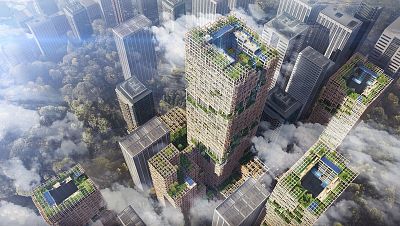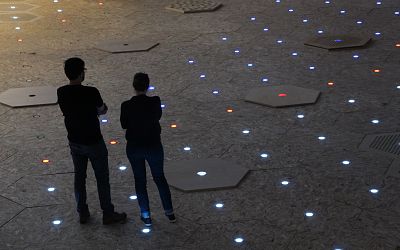Carlo Ratti says the way we move, communicate and shop will be "radically different from how it is today."
What will cities be like in the future? Scientists, engineers and architects have made all sorts of predictions about changes they expect to see in the urban landscape, from flying taxis to package-fetching robot dogs — even a colossal skyscraper suspended from an asteroid.
Carlo Ratti is more down to Earth. "I think that the city of tomorrow will not be too different from the city of today," says the architect and designer who heads up MIT's Senseable City Lab. "As humans, we will always need horizontal floors for living, vertical walls in order to separate spaces and exterior enclosures to protect us from the outside."
But Ratti says urban landscapes and lifestyles will undergo big changes within the next decade. "New technologies will have an impact on the experience of the city more than on its physical form," he says. "The way we move, communicate and shop will be radically different from how it is today."
Recently, Ratti spoke via email with NBC News MACH about his vision of the city of tomorrow. The interview has been edited for clarity and brevity.
MACH: Let's start with transportation. When we leave our homes in the morning, will we hop into self-driving cars — or maybe autonomous drones?
Carlo Ratti: Thanks to Uber and Zipcar, I got rid of my car in Boston a few years ago — and this is going to increase with self-driving cars. However, I do not think that I will use a drone! There are financial, technological and safety reasons for why we should keep our urban transport on the ground.
Will there be other options besides self-driving cars?
Yes, of course — and that is one of the things I am most excited about. Digital data can empower individuals to pick from a "transportation portfolio," a menu of options based on real-time information [that could include] bicycling, sharing a car, walking, taking an on-demand taxi, using the subway or train and hitching a ride with friends. This will require an integrating platform in a similar way to what happened with the airline industry a few decades ago.
So we'll go to a website and pick the best option, maybe even making reservations like I would for air travel?
Yes, it could work like that.
What about roads themselves? I saw you designed a system that could allow roads to be used for more than car traffic.
The adaptable paving system, called The Dynamic Street, was developed for the Quayside project in Toronto by Alphabet's Sidewalk Labs with our design practice Carlo Ratti Associati. Imagine a street, flanked by stores and residences, that during morning rush hour is cleared for self-driving vehicles, and in the afternoon, through shifting light signals and insertable elements like poles, becomes a playground for children. In the evenings or weekends, it could be freed up for a basketball game or block party.
Innovation
The Dynamic Street represents our vision of a future where living and mobility become more flexible and responsive with the use of digital technologies, and as a consequence, public, communal spaces can increase.
You mentioned that the buildings of the future will still need walls, a floor and ceiling. But it seems there are a lot of ways they could change. What do you think could happen?
What I think is interesting in terms of how buildings will change in the future is how our experience of them will change, as they will no longer be solely physical, but hybrid physical and digital entities.
For instance, our renovation of the headquarters of the Angelli Foundation in Torino, Italy, did not set out to radically alter the building itself. Our most significant innovation was to distribute sensors throughout the building that could track users' presence and respond with customized heating, air conditioning and lighting — creating, in essence, individually tailored environmental conditions to improve individual comfort while slashing energy consumption.
I imagine buildings in the future will also increase the use of sensors to respond in real time to their users' needs and desires.
Do you think living and working spaces could get smaller? Some people have talked about room furnishings that reconfigure themselves so one room can have multiple uses.
Reconfigurability is certainly another interesting aspect. However, other aspects are contributing to reducing square meters or feet per person. We like the idea of co-living. The combination of all these trends — co-working, co-living and reconfiguring furniture — can help us make better use of space, hence turning real estate more affordable in today's exorbitantly expensive world cities.
Co-working involves a shared workspace in which people work independently. But can you explain co-living? Will apartment buildings of the future be more like dorms?
Not necessarily college dorms. However, lifestyles have changed, and therefore a residential model based around nuclear families with static working lives may no longer be the most appropriate one for many people. Co-living will not mean the renunciation of private spaces, but the sharing of certain key spaces, like major living rooms, ample balconies and key services — think about a professional kitchen — encouraging a more communal lifestyle.
Who would co-living buildings serve?
For obvious reasons, co-living buildings might initially seem more adept for single professionals, whose lifestyles are often flexible and not so tied down to a specific place, and who could benefit most from sharing resources. That being said, there is no reason why families could not also participate in co-living. The enabler is the possibility to schedule and book online, perhaps with a system of fees and rewards in order to avoid misuse of the system.
What about new approaches to building — like wooden skyscrapers?
Architecture has always been about finding new materials or improving the use of old ones. Wood certainly belongs to this category and has many advantages in terms of versatility and sustainability. We will not be able to build the tallest building in the world with standard wood, but we can certainly use it in tall structures.
Science
Earlier you mentioned communications will change — but how?
Our cities produce a staggering amount of data. If this data is shared and evenly distributed, people can start to use it to create new services and businesses, or even just to advocate for a better metropolis.
Recently, at our MIT lab we developed a research study focusing on how we can better assess the soundness of the aging American infrastructure. In our study, which used the Golden Gate Bridge as a case study, we show how accelerometers embedded in most mobile phones can help crowdsource accurate data on the kinds of vibrations bridges are producing. In other words, every time you cross a bridge you can use your smartphone as an inspection device.
You also mentioned changes in how we shop. Please talk about where you see that going.
On one hand, we will increasingly use digital services to purchase down-to-earth products — such as toilet paper, laundry soap, milk and so on. On the other hand, I see a blossoming of "experiential" shopping. Think about choosing fresh food produce: We will always enjoy going to a physical store where we can touch and smell. The store, in turn, can become increasingly focused on providing us with unique experiences.
What's one thing you hope won't show up in future cities?
I hope we can learn from the limits of a certain model of smart city that we have seen in the recent past, and not repeat those mistakes. I am talking about those top-down developments that see technology as an end per se, rather than just a means to encourage better relations between people.
I prefer to use the term "senseable city" instead of "smart city." "Senseable" implies both the ability of digital technologies to sense the environment and citizens' needs, and the fact of being "sensible" — putting people at the core.
How do we nurture the human side?
It is a matter of focus: not making cities run like clockwork, but allowing for citizen input to be included. A good example is the Office of New Urban Mechanics, an initiative of the city of Boston. The office has set out to digitalize the city. Through apps like Citizen Connect, which is like a real-time, digital version of a call center, citizens can report problems to the city, allowing the mayor's office to respond directly to their requests and using smart technologies to facilitate a bottom-up approach to governance and problem-solving.













